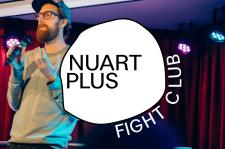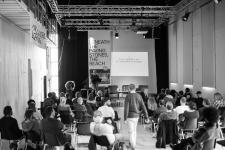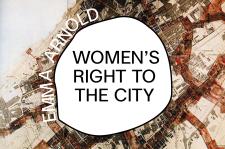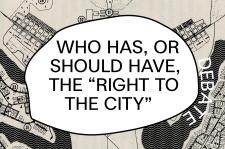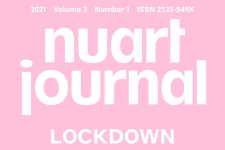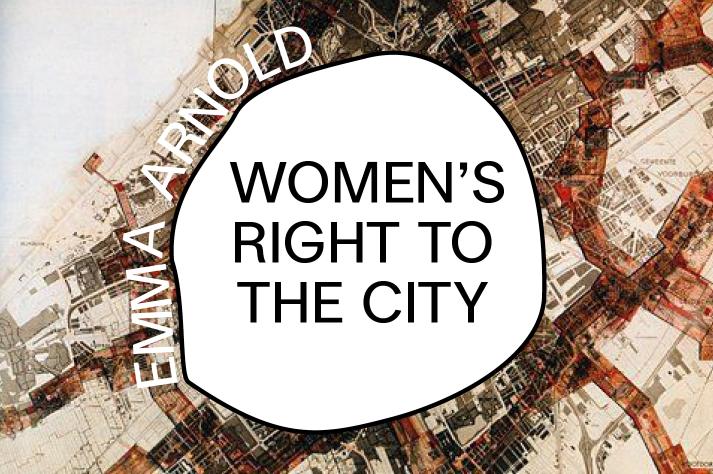
WOMEN’S RIGHT TO THE CITY
By Emma Arnold
The greatest impact we can make in the city is to leave our mark upon it. So writes Henri Lefebvre in 1945: “Everyday life is not unchangeable; it can decline, therefore it changes. And moreover the only genuine, profound human changes are those which cut into this substance and make their mark upon it”(1). Henri Lefebvre is the French Marxist sociologist and philosopher best known for his conceptualisation on the 'right to the city'(2) and whose ideas on the urban continue to resonate. Though the right to the city as a concept is experiencing a resurgence, there is a signi cant omission in Lefebvre’s articulations and its myriad interpretations. Not everyone has the same access to the city. Race, gender, ability, sexuality, and other dimensions of difference in uence mobilities and access to the city. Ignoring difference is problematic for it reproduces inequalities in the city and its capitalist and patriarchal power structures.
It is in Lefebvre’s key ideas on the critiques of the everyday where the Situationists certainly took inspiration. The Situationists, an organisation of avant-garde artists and theorists active in the 1950s and 1960s, believed that in intervening in everyday spaces of the city where capitalism is made and remade, capitalist forces shaping everyday life and society might be ruptured(3). The Situationists’ psychogeographic wanderings and artistic practices in the city were charged with political and creative energies(4) which are re ected in the works of many contemporary urban artists. In making marks in the street, the elite space of the gallery may be (momentarily) circumvented and the machinations of the art market challenged. Though art markets have indeed embraced and subsumed urban aesthetics and subversions of the street, pieces in the city still gain their meanings from their geography as much as their aesthetics. One might argue that gra ti writers and street artists intervening in the everyday embrace so well and in many ways exemplify Lefebvre’s right to the city which involves the rights to appropriate, use, and participate in urban space(5).
Women have not had the same opportunities as men, however, to appropriate, use, and participate in urban space. The city has long been seen as a place for men while domestic spaces of the home have been reserved for women(6). This gendered division between public and private spheres perseveres despite feminist strides. Men move more easily throughout the city while women’s mobilities are wholly di erent, often adjusted and mediated by time of day and type of space(7). The city at night is frequently considered unsafe, leading women to consequently alter their routes through the city(8). Street harassment, threats, and fears of sexual assault and violence keep women from the city at night, and at the very least in uence how they navigate it. Women’s bodies in the city at night are also sexualised; euphemisms such as “women of the night” and “street walkers” hint at how women’s presence in the city at night has been historically for sexual consumption by men(9).
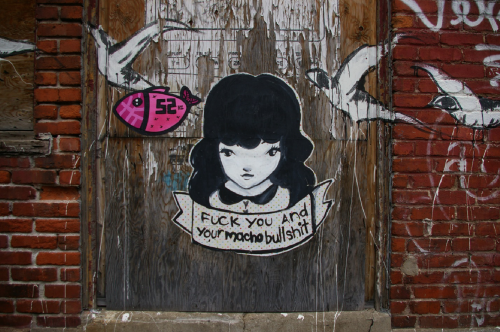
[Figure 1]
Littlestarchild with 52hz as part of the OFFmuralES10 movement, contesting the male dominated artist line-up for Montréal’s first Muralfest, Montréal (2013)
Graffiti, and perhaps to some extent street art, are often framed as masculine activities(11). To succeed in such environments, it has frequently been masculine traits which are favoured and valorised, such as strength, bravery, and toughness. Though women are involved and have been since the very beginning, they have not been written into the subculture’s history in the same ways as men. The myth of the male vandal has bene ted politicians, particularly in contexts of strict policies against gra ti in which portraying writers as aggressive and male has facilitated public support for wars on gra ti. Indeed, wars on gra ti under regimes of strict or zero tolerance have also had gendered rami cations on the city. What began as a culture open to women became less accessible as security intensi ed and penalties became more severe in many cities(12). Women have been less prone to take risks in such environments(13).
Graffiti writers and street artists, particularly when working illegally, appropriate space and remake the city. This is often done at night and in spaces which are not always safe, particularly not for women. As such, women do not have the same ease of access to create and intervene in the city. Institutions surrounding these cultures are also male dominated. Street art and mural festivals are habitually organised and managed by men and dominated by male artists. Scholars writing on urban issues, including those writing on graffiti and street art, are also most often men. Despite underrepresentation, there are nevertheless very many female artists working in the streets though they are a minority and work under different conditions.
Neoliberal urban governance has done little to improve women’s right to the city. Zero tolerance as a policy approach is emblematic of neoliberal trends in cities as are the increased public-private partnerships which bring advertising giants like ClearChannel and JCDecaux into virtually every space of the city. In regimes in which graffiti and street art are habitually cleansed from the city, an atmosphere in which advertising flourishes is created. In these advertising spaces on walls and sidewalks, buses and trams, and all manner of public infrastructure, idealised and sexualised images of women are also brought into the city. These images intensify the masculine city, allowing women to serve as not only decoration for the heteronormative male gaze but also contributing to a worrying sexualising of space. In low ambient light, these backlit images dominate urban spaces at night, at times when women are most at risk and fearful.

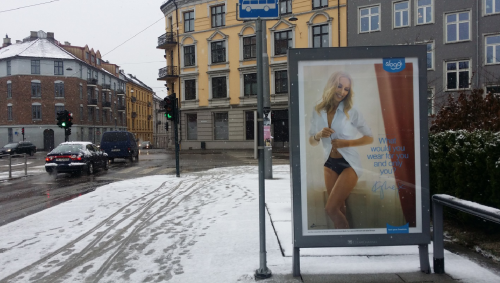
[Figures 2 and 3]
Effects of sexualised advertising in the city exacerbated at night, Oslo (2015)
It is not just the idealised representations of women’s bodies, predominantly thin and white, which are problematic in outdoor advertising. These depictions in advertising and popular culture are well known to have negative impacts on women’s sense of self and body. The sexualised images of women in advertising are harmful in other ways. Women in various states of undress in sexually suggestive poses, intimating everything from masturbation to fellatio, reinforce dominant and mainstream ideas of heteronormative sexuality which keep women in subordinate positions and for male consumption(14). The presence of these images in the city present a whole new set of problems(15), for outdoor advertising is situated in everyday spaces which we cannot avoid, further implicating women’s right to the city(16).
Graffiti and street art offer opportunities to resist and disrupt this increasing commodification of urban space. The alternative aesthetics offer a diversion from the images of advertising which take over vital public space. Women’s different access to the city has certainly affected their participation in the culture of urban art. Yet, women’s actions are needed now more than ever. If Lefebvre wrote that we might contest capitalism though making marks and intervening in the city – a capitalism patriarchal in its very nature – it is women intervening in the city whose actions may contest the patriarchal nature of an urban space which is persistently masculine and ever sexualised.
Footnotes
1 Lefebvre, Henri. 1945. Critique of Everyday Life: The Three Volume Text by Henri Lefebvre (2014). Verso: London
2 Lefebvre, Henri. 1968. Right to the city. In Writings on Cities (1996). Eds Eleonore Kofman and Elizabeth Lebas. Blackwell Publishing, Oxford:147–159
3 Pinder, David. 2009. Situationism/situationist geography. In International Encyclopedia of Human Geography. Eds Rob Kitchin and Nigel Thrift. Volume 10. Elsevier, Oxford: 144–150
4 Debord, Guy. 1963. New forms of action in politics and art. In Situationist International Anthology. Ed Ken Knabb. Bureau of Public Secrets, Berkeley: 62–66
5 Purcell, Mark. 2003. Citizenship and the right to the global city: Reimagining the capitalist world order. International Journal of Urban and Regional Research. 27(3): 564–590
6 Fenster, Tovi. 2005. The right to the gendered city: Different formations of belonging in everyday life. Journal of Gender Studies. 14(3): 217–231
7 Cresswell, Tim and Uteng, Tanu Priya. 2008. Chapter 1. Gendered mobilities: Towards an holistic understanding. In Gendered Mobilities, Eds Tim Cresswell and Tanu Priya Uteng. Ashgate, Aldershot: 1–12
8 Valentine, Gill. 1989. The geography of women’s fear. Area. 21(4): 385–390
9 Solnit, Rebecca. 2014. Wanderlust: A History of Walking. London: Granta
10 Mairet, Aline. 2013. Off-Murales, a feminist vision of street art in Montreal, Canada. Vandalog. https://blog.vandalog.com/2013/08/off-murales-a-feminist-vision-of-street-art-in-montreal-canada/
11 Gélinas, Éliane. 2013. The myth of the graffiti whore: Women’s bodies in a masculinist subculture. Yiara Magazine. 1:32–36
12 Dickinson, Maggie. 2008. The making of space, race and place: New York City’s war on graffiti, 1970–the present. Critique of Anthropology. 28: 27–45
13 Macdonald, Nancy. 2001. The Graffiti Subculture: Youth, Masculinity, and Identity in London and New York. New York: Palgrave Macmillan
14 Blloshmi, Ana. 2013. Advertising in post-feminism: The return of sexism in visual culture? Journal of Promotional Communications. 1(1): 4–28
15 Rosewarne, Lauren. 2005. The men’s gallery. Outdoor advertising and public space: Gender, fear, and feminism. Women’s Studies International Forum. 28: 67–78
16 Arnold, Emma. 2016. Invisible walls: Sexualising the city through outdoor advertising. Manuscript submitted for publication
FIGHT CLUB - MAKING HISTORY WITH 'POST-STREET ART'
Fight Club was established in 2012 as a way to introduce difficult topics in a more relaxed environment condusive to public engagement.
NUART PLUS 2016 PROGRAM
This year’s Nuart Plus symposium will explore the topics of ‘Utopia and Rights to the City’ and ‘Dada, Art and Everyday Life’ on the 500th anniversary of Thomas M...
NUART PLUS 2016 - DAY 1 - KENNARDPHILLIPPS Talk & Q&A Session
Utopia, from the artists perspective
Artist presentation by Kennardphillipps, followed by a Q&A session with Carlo McCormick.
NUART PLUS 2016 - DAY 1 - NUTOPIA
Nutopia panel debate
Discussion led by: David Pinder
Panel: Pedro Soares Neves, Peter Bengtsen, Emma Arnold
NUART PLUS 2016 - DAY 2 - JEFF GILLETTE AND HENRIK ULDALEN
Panel debate: The Borders of Street Art
Artists presentations by Jeff Gillette and Henrik Uldalen, followed by a Q&A session with Evan Pricco
WOMEN’S RIGHT TO THE CITY
By Emma Arnold
SUBVERTING AND CONTESTING THE MASCULINE AND SEXUALISED CITY
CARLO McCORMICK (US)
Pop culture critic, curator, and Senior Editor of PAPER magazine
EMMA ARNOLD (CA)
Research Fellow, University of Oslo Department of Sociology and Human Geography
PEDRO SOARES-NEVES (PT)
Founder, Lisbon Street Art and Urban Creativity
PETER BENGTSEN (SE)
Art historian and sociologist, Department of Arts and Cultural Sciences, Lund University
DEBATE: WHO HAS, OR SHOULD HAVE, THE "RIGHT TO THE CITY"
Henri Lefebvre’s "right to the city" concept provokes us to consider how we might remake the city with the goal of creating more just and ideal societies.
WALL WRITERS FILM SCREENNG
Nuart Festival and SF Kino Stavanger present Wall Writers: Graffiti in its Innocence


